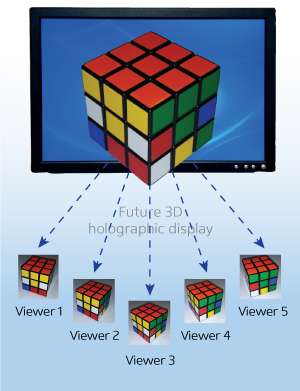Creating high-resolution full-color moving holograms in 3-D

Three-dimensional (3D) movies, which require viewers to wear stereoscopic glasses, have become very popular in recent years. However, the 3D effect produced by the glasses cannot provide perfect depth cues. Furthermore, it is not possible to move one's head and observe that objects appear different from different angles—a real-life effect known as motion parallax. Now, A*STAR researchers have developed a new way of generating high-resolution, full-color, 3D videos that uses holographic technology.
Holograms are considered to be truly 3D, because they allow the viewer to see different perspectives of a reconstructed 3D object from different angles and locations (see image). Like a photograph, a hologram contains information about the size, shape and color of an object. Where holograms differ from photographs is that they are created using lasers, which can produce the complex light interference patterns, including spatial data, required to re-create a complete 3D object.
However, generating high-resolution, moving holograms to replace current 3D imaging technology has proved difficult. To enhance the resolution of their holographic videos, Xuewu Xu and colleagues at the Data Storage Institute in Singapore used an array of spatial light modulators (SLMs).
"SLMs are devices used in current two-dimensional projectors to alter light waves and generate projections," explains Xu. "In a 3D holographic display, SLMs are used to display hologram pixels and create 3D objects by light diffraction. Each SLM in our system can display up to 1.89 billion hologram pixels every second, but this resolution is not high enough for a seamless large video display."
To address this challenge, Xu and his team divided every frame of their hologram video into 288 sub-holograms. They then streamed the sub-holograms through 24 high-speed SLMs stacked together in an array. This technique was combined with optical scan tiling, which uses a scanning mirror to combine the signals from the SLMs, thus filling in any gaps in the physical tiling array. Finally, the researchers sped up the full-color video playback using powerful graphics processing units. This combination of technologies produced one high-resolution, full-parallax moving hologram displaying 45 billion pixels per second.
"We increased the resolution of the holographic display system by 24 times," states Xu. "The full-color 3D holographic video plays at a rate of 60 frames per second, so it appears seamless to the human eye."
Potential applications of the new technique include 3D entertainment and medical imaging. However, new SLM devices with a smaller pixel size, higher resolution and faster frame rate are required before large-scale 3D holographic video displays can become reality.
More information: Xu, X., Liang, X., Pan, Y., Zheng, R. & Lum, Z. A. Spatiotemporal multiplexing and streaming of hologram data for full-color holographic video display. Optical Review 21, 220–225 (2014). dx.doi.org/10.1007/s10043-014-0032-y




















